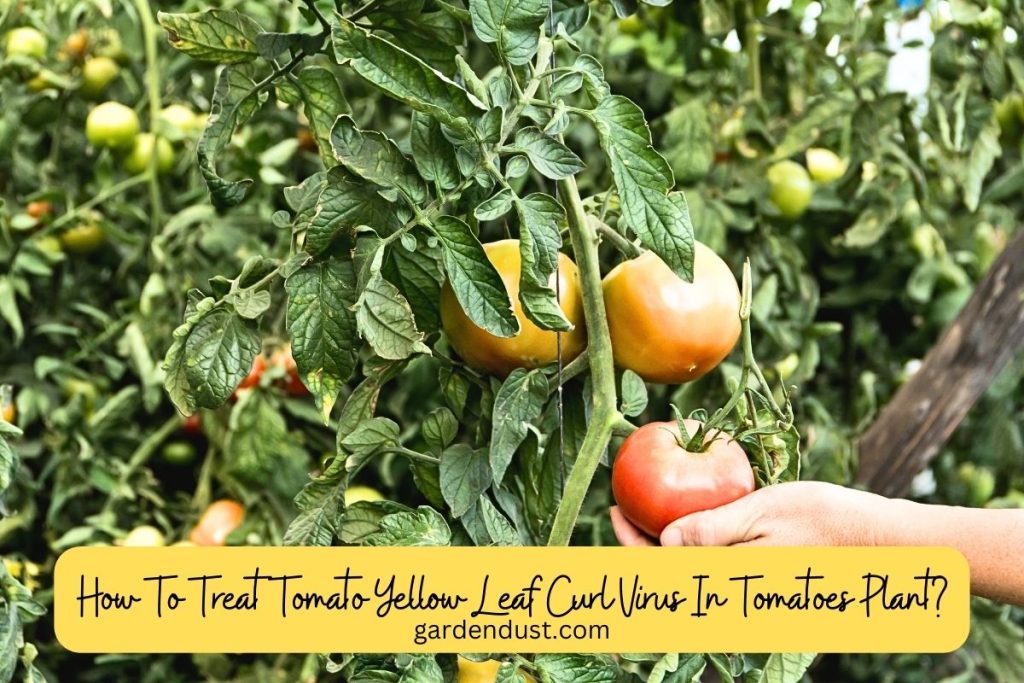What is Tomato Yellow Leaf Curl Virus?
Tomato Yellow Leaf Curl Virus (TYLCV) is a viral disease that affects tomato plants, causing significant damage and reducing yield. It is transmitted by whiteflies and can quickly spread throughout a garden or field. In this article we will explore How To Treat Tomato Yellow Leaf Curl Virus in tomatoes plant also understand the symptoms, causes for TYLCV is crucial for managing and preventing its spread. Let’s delve into each aspect:
Symptoms:–

The symptoms of TYLCV can vary, but they generally include:
- Stunted growth: Infected tomato plants often exhibit stunted growth compared to healthy plants. The overall size of the plant may be smaller, and the affected plants may lag behind in development.
- Leaf curling: One of the distinctive symptoms of TYLCV is the curling of the tomato plant’s leaves. The leaves may curl upward or inward, giving them a distorted appearance.
- Yellowing of leaves: The leaves of infected plants may develop a yellow coloration, starting from the base of the plant and spreading upwards. The yellowing typically occurs between the veins of the leaves.
- Reduced fruit production: TYLCV can lead to a significant reduction in fruit yield. Infected plants may produce fewer or smaller fruits compared to healthy plants.
What Causes Of Tomato Yellow Leaf Curl Virus (TYLCV)?
TYLCV is caused by a group of viruses called begomoviruses. These viruses are transmitted by whiteflies (Bemisia tabaci) that feed on the sap of infected plants and subsequently infect healthy plants. Once a plant is infected, the virus spreads systemically throughout the plant, causing the characteristic symptoms of TYLCV.
Read Also :-Irregular Fruit Development In Tomato:-Symptoms, Cause, Prevent
How To Treat Tomato Yellow Leaf Curl Virus (TYLCV)?
Currently, there are no known cures for TYLCV. Once a plant is infected, it cannot be treated to eliminate the virus. However, there are measures you can take to manage the disease and reduce its impact:
- Remove infected plants: Promptly remove and destroy any tomato plants showing symptoms of TYLCV. This will help prevent the spread of the virus to healthy plants.
- Manage whiteflies: Control whitefly populations to minimize the spread of TYLCV. This can be achieved through various methods, including the use of insecticidal soaps, neem oil, or insecticides specifically targeting whiteflies. Regularly monitoring and removing infested leaves or plants can also help reduce whitefly populations.
- Physical barriers: Use physical barriers such as insect netting to exclude whiteflies from reaching the tomato plants. This can be especially effective in preventing the initial infection of healthy plants.
- Resistant varieties: Plant tomato varieties that are resistant to TYLCV. Some tomato cultivars have been bred to have resistance or tolerance to the virus, which can significantly reduce the impact of the disease.
- Sanitation practices: Practicing good garden hygiene can help manage TYLCV. Remove and destroy any weeds or host plants that may harbor the virus or whiteflies. Clean gardening tools and equipment to prevent the spread of the virus.
Prevention is key when it comes to managing TYLCV. Taking proactive measures to control whiteflies, using resistant varieties, and practicing good garden sanitation can help reduce the incidence and impact of the disease.
Final Thoughts
Tomato Yellow Leaf Curl Virus (TYLCV) is a challenging disease that can severely affect tomato plants and reduce yields. While there are no cures for the virus, implementing preventive measures such as removing infected plants, managing whitefly populations, using physical barriers, and planting resistant varieties can help manage the disease and minimize its spread. By adopting these strategies, you can protect your tomato plants and increase the chances of a successful harvest. Happy Gardening….






